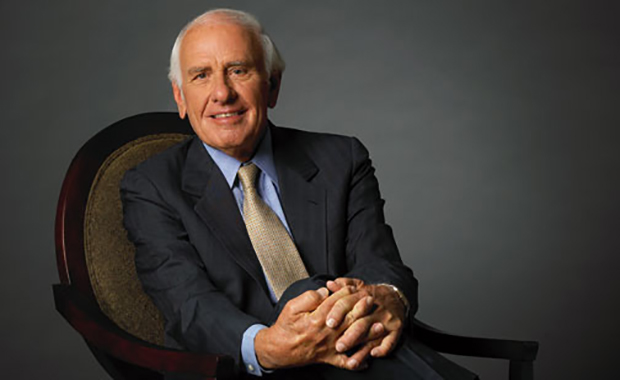Success Advice
7 of the Best Time Management Tips From the Master of Success, Jim Rohn

Becoming a master at time management will allow you to design and improve every aspect of your life. Jim Rohn was one of the most influential speakers when it came to this. His tips and tricks are very actionable and revive a sense of motivation in millions of people to date. Managing your time meticulously is easier said than done but just like anything great you will ever accomplish, the hardest step is to begin. Try not to just read through these steps but to put them into action.
Here are 7 time management tips from Jim Rohn:
1. If you don’t design your own life plan, chances are you’ll fall into someone else’s plan
Designing your life is a nice way of saying ‘don’t let life happen to you, make your life happen’. A ship that leaves its dock without a planned destination will wonder the seas aimlessly and guess what, it will never get to where it was meant to be. Every day is an accumulation of time, therefore, managing your time is managing your day. This will lead to having your life planned out, day by day until you realize you have achieved most, if not all, of your goals.
2. Think on paper
Write down your goals and dreams. This might be a document, app, or the old-fashioned pen to paper, but this is not an option. There is something special that happens when we jot down our goals, because the mind begins to see them as actionable steps not just dreams.
Most people say they want to be successful and dream about being great, but have never written it out the steps to get there. Meticulously plan and schedule your life in real time on paper. This will lead to the next step which is planning out how you will achieve your goals.
3. When you don’t control your time, your time will control you
Have you ever experienced a day in which you did not plan out your time and before you knew it, you had gotten nothing done? This is how most people’s lives go by. They have no specific plan for their time and therefore for their lives. Your choices determine the person you end up being. See every moment as an opportunity to savor the time and make the most of it.. If you control how you spend your time, you can control your successes and failures.
“Days are expensive. When you spend a day you have one less day to spend. So make sure you spend each one wisely.” – Jim Rohn
4. If it’s easy to do, it’s easy to NOT do
We kid ourselves, ‘Ah, that’s simple, why should I plan it out, I’ll just do it!’ This has proven not to work time and time again. Simply because if it’s easy to do, it is easy not to do. We are a product of the things we continuously do.
The Compound Effect by Darren Hardy is structured around a simple principle. Every single action, no matter how small, if done over and over again will compound to a much larger product. The small things we ignore and don’t do because we never plan for them will eventually accumulate to some big action we now have to take which will be much harder.
5. Without a sense of urgency, desire loses value
If you don’t plan out your time you are not putting a timeline on your goals. Having deadlines creates a sense of urgency. This is why we start to work on a month-long project around the last week to the deadline. The pressure makes it seem dire and will act as a type of motivator to completing and accomplishing our goals. Put a deadline on your dreams, otherwise they are just that, dreams.
6. Study the art of setting goals
Every day, write your goals fresh without focusing on yesterday. This is a good way to weed out non-priorities and refocus on your true goals. Focus is something lacking in today’s society. Don’t fall ‘victim’ to this, so review your goals on a daily basis to reinforce them and make realizing them practical. Derek Mills suggests a Daily Standards system where we don’t necessarily work towards a long time goal but focus on daily goals which eventually turn into long-term successes.
“Either you run the day or the day runs you.” – Jim Rohn
7. We all have the same amount of time in a day
Start where you are, it doesn’t matter where you are now. 90% of millionaires started out broke. The key to success is taking a lot of action on a great idea and the only way to do this is to manage your time. Plan around every single action, no matter how simple. You can turn your life around at any given moment. The best way to do this is by time management.
Start simple by having a notebook where you write down how you spend every hour of your time. If you surf the web for 2 hours, write it down. If it takes you 30 minutes to stalk your favourite celebrity, write it down. Everything you do, for one week, write it down. In the end, you will see where most of your time goes.
You will also start to resent having to write down that you spent one hour looking at pictures of a car you could only afford if you actually used that time wisely. This is a great place to start, from there you can follow the many time management tips available to you and see what works best for you.
How do you manage your time to get the best results? Let us know in the comments below!
Did You Know
How Skilled Migrants Are Building Successful Careers After Moving Countries
Behind every successful skilled migrant career is a mix of resilience, strategy, and navigating systems built for locals.

Moving to a new country for work is exciting, but it can also be unnerving. Skilled migrants leave behind familiar systems, networks, and support to pursue better job opportunities and a better future for their families. (more…)
Life
10 Research-Backed Steps to Create Real Change This New Year
This New Year could finally be the one where you break old patterns and create real, lasting change.

Every New Year, we make plans and set goals, but often repeat old patterns. (more…)
Change Your Mindset
The Silent Skill That Makes People Respect You Instantly
What truly earns respect and why most people go about it the wrong way

Everybody craves respect but not everyone earns it. Some people believe that a title, years of experience, or a position of authority automatically entitles them to respect. (more…)
Entrepreneurs
The Essential Skills Every Entrepreneur Needs In 2026
Success in the digital age isn’t about luck. It’s about mastering the skills that separate dreamers from doers.

When I was 22 years old, I started my first side hustle as a ghostwriter. (more…)
-

 Shift Your Mindset4 weeks ago
Shift Your Mindset4 weeks ago11 E’s That Define Every Great Leader And Why Most People Miss Them
-

 Did You Know3 weeks ago
Did You Know3 weeks agoThe Success Patterns You Inherited (And Didn’t Notice)
-

 Entrepreneurs3 weeks ago
Entrepreneurs3 weeks agoThe Essential Skills Every Entrepreneur Needs In 2026
-

 Business3 weeks ago
Business3 weeks agoThe Hidden Money Pit in Your Operations (and How to Use It)
-

 Change Your Mindset2 weeks ago
Change Your Mindset2 weeks agoHow to Turn Your Mind Into Your Greatest Asset (Instead of Your Enemy)
-

 Change Your Mindset2 weeks ago
Change Your Mindset2 weeks agoThe Silent Skill That Makes People Respect You Instantly
-

 Life1 week ago
Life1 week ago10 Research-Backed Steps to Create Real Change This New Year
-

 Tech1 week ago
Tech1 week agoWhat’s in a Name? How to Get Your Domain Right

























5 Comments